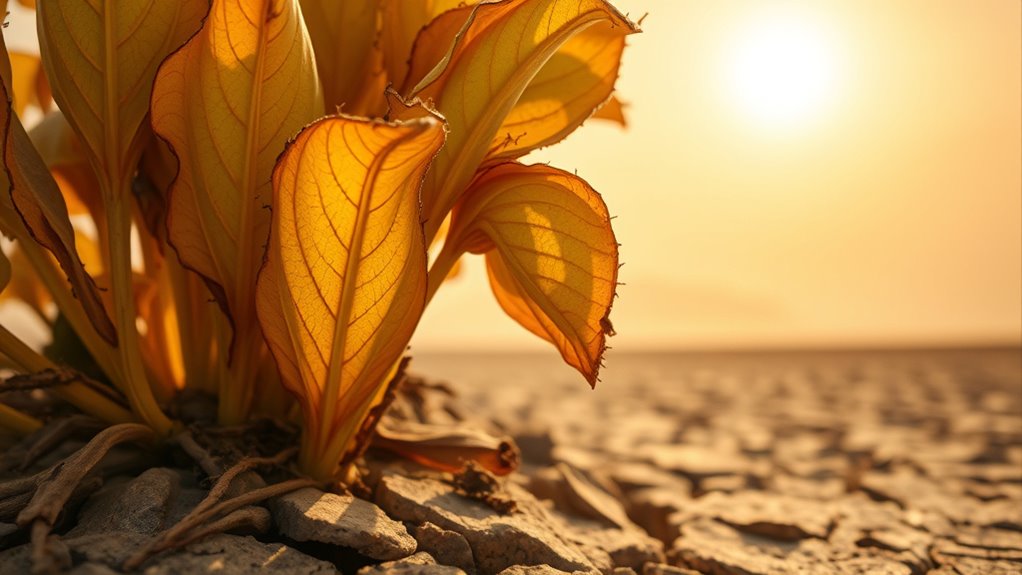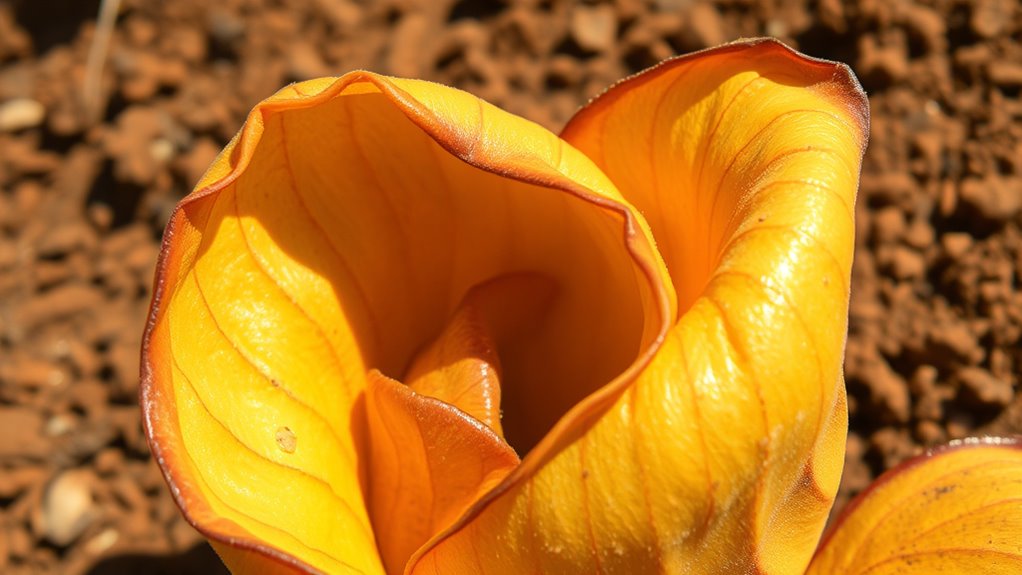During a heatwave, your plants activate defenses like closing stomata to conserve water and producing heat shock proteins to protect cellular functions. They may develop deeper roots and alter membrane lipids to maintain stability. However, if the heat persists or intensifies, these mechanisms can be overwhelmed, leading to protein misfolding, oxidative damage, and cell death. Understanding these processes helps you recognize how plants respond and what factors threaten their survival during extreme temperatures.
Key Takeaways
- Heatwaves trigger plant responses like stomatal closure, deep root growth, and dormancy to conserve water and energy.
- Elevated temperatures cause protein misfolding and enzyme denaturation, impairing cellular functions.
- Heat stress leads to overproduction of reactive oxygen species (ROS), causing oxidative damage to cellular components.
- Plants produce heat shock proteins that refold damaged proteins and stabilize cell structures during heat stress.
- Prolonged or intense heat overwhelms defenses, resulting in cell damage, impaired photosynthesis, wilting, and potential plant death.

Have you ever noticed how plants struggle during a heatwave? When temperatures soar, your plants face intense stress that tests their survival. One of their key challenges is drought adaptation. During prolonged dry spells, plants activate various mechanisms to conserve water and protect themselves. They might close their stomata—tiny pores on leaves—to reduce water loss, even though this limits photosynthesis. Some plants develop deeper root systems to access underground moisture, while others enter a state of dormancy, halting growth to conserve energy. These strategies are essential, but they’re not foolproof. The rapid rise in temperature can still cause significant cellular damage, weakening the plant’s overall health.
Cellular damage occurs when heat disrupts the structure and function of cells. High temperatures cause proteins and enzymes essential for metabolism to misfold or denature. When these critical molecules malfunction, the plant’s cellular processes slow down or stop altogether. Additionally, heat stress can lead to the overproduction of reactive oxygen species (ROS), which are harmful molecules that damage cell membranes, DNA, and other crucial components. To combat this, plants produce antioxidants—molecular defenders that neutralize ROS—yet under extreme heat, their defenses can become overwhelmed. The result is compromised cell integrity, impairing growth, photosynthesis, and even leading to cell death.
Heat causes proteins to misfold, leading to cell damage and impaired plant functions.
Inside the plant, heat triggers a cascade of physiological responses aimed at minimizing damage. For example, heat shock proteins are produced to help refold damaged proteins and stabilize cellular structures. These proteins act like molecular bandages, preventing irreversible harm. Additionally, plants can alter membrane lipid composition, increasing the production of heat-tolerant fats that maintain membrane fluidity at elevated temperatures. Despite these adaptive responses, the balance is delicate; if the heat persists or intensifies, the cellular damage can become irreversible, leading to visible symptoms like wilting, leaf scorch, or even plant death. Research also suggests that some plants can produce heat-shock proteins as an additional protective measure to bolster cellular resilience during extreme conditions.
Understanding these internal processes reveals how delicate plants are during heatwaves. Their survival hinges on a complex interplay of drought adaptation strategies and cellular defenses. When these mechanisms are overwhelmed, cellular damage accumulates, and the plant’s ability to recover diminishes rapidly. Recognizing this helps you appreciate the resilience required for plants to endure extreme heat and underscores the importance of providing shade, adequate watering, and other protective measures to support them during such stressful periods.
Frequently Asked Questions
How Do Heat-Stressed Plants Recover After a Heatwave?
After a heatwave, you can help heat-stressed plants recover by ensuring they experience proper hydration and shade. They recover through processes like heat shock response, which helps repair damaged proteins, and osmoprotectants production, that stabilizes cell structures. By supporting these mechanisms, you enable your plants to regain strength, reduce stress, and restore normal growth. Keep an eye on their condition, and provide consistent care to promote full recovery.
Can Heat Stress Affect Plant Reproductive Success?
Ever wonder if a heatwave throws a wrench in plant romance? Well, it does! Heat stress can cause pollination disruption, making it harder for plants to reproduce. Plus, seed viability drops, so even if pollination occurs, the seeds might not grow. You’re basically watching your garden’s love life falter, all thanks to the sizzling heat. Nature’s heartbreak, and you’re caught in the middle!
What Are the Long-Term Effects of Repeated Heat Stress?
Repeated heat stress can have lasting effects on plants. You might see genetic adaptation over generations, helping plants better tolerate heat. Epigenetic memory can also play a role, allowing plants to “remember” past stress and respond more effectively in future conditions. However, persistent heat stress may weaken plant health, reduce reproductive success, and decrease yields, making it essential to understand and mitigate these long-term impacts for sustainable growth.
How Does Heat Stress Influence Plant Pathogen Susceptibility?
Did you know heat stress can increase plant pathogen susceptibility by up to 50%? When your plants face heat, it triggers pathogen activation, making them more vulnerable. Simultaneously, heat causes immune suppression, weakening their defenses. This combination means your plants are less able to fight off infections, leading to higher disease risks. Understanding this helps you take proactive measures to protect your plants during heatwaves and maintain their health.
Are Some Plant Species More Heat-Tolerant Than Others?
You’ll find that some plant species are more heat-tolerant because of genetic adaptation and specific physiological mechanisms. These plants have evolved traits like better water retention, heat-shock proteins, and efficient cooling systems. You can observe that they withstand higher temperatures longer and recover faster after heatwaves. Understanding these differences helps you select resilient species for hotter climates, ensuring better growth and survival during extreme heat events.
Conclusion
As you watch a heatwave sweep through plants, remember they’re like delicate glass sculptures, fragile yet resilient. Their physiology works tirelessly like tiny engines, trying to keep cool and survive the fiery storm. With each leaf and root fighting to maintain balance, you see nature’s incredible resilience firsthand. When you understand these hidden struggles, you gain a deeper appreciation for how plants endure and adapt, standing strong like silent warriors amid the blazing heat.










